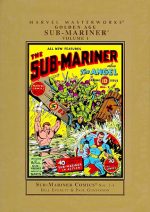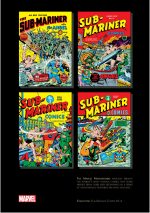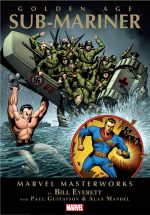


By Bill Everett, Paul Gustavson, Roy Gill, Harry Sahle, Lewis Glanzman, Stan Lee, Alan Mandel, Mickey Spillane, Art Gates, Basil Wolverton & others (Marvel)
ISBN: 978-0-7851-1617-2 (HB) 978-0-7851-5789-2 (TPB/Digital edition)
Win’s Christmas Gift Recommendation: The Sea Son’s Greatest Golden Moments… 8/10
Prince Namor, the Sub-Mariner was the second super-star of the Timely Age of Comics – but only because he followed the cover-featured Human Torch in the running order of Marvel Comics #1 in October 1939. He has had, however, the most impressive longevity of the company’s “Big Three”: Torch, Subby and Captain America…
The Marine Marvel was revived in 1962, an unbeatable force in Fantastic Four #4; once again an anti-hero/noble villain, prominent in the company’s pantheon ever since.
In world, the hybrid offspring of an undersea Atlantean princess and American polar explorer is a being of immense strength: highly resistant to physical harm, able to fly and thrive above and below the waves.
Created by young Bill Everett, Namor technically predates Marvel/Atlas/Timely Comics entirely, and first caught the reading public’s attention as part of the “Fire vs. Water” headliners in the anthological Marvel Comics #1 – which became Marvel Mystery Comics with the second issue. His elementally apposite co-star was the Human Torch, but Namor had originally been seen – albeit in a truncated version – in the monochrome freebie Motion Picture Funnies: a weekly promotional giveaway handed out to moviegoers earlier that year.
Swiftly becoming one of Timely’s biggest draws, Namor won his own title at the end of 1940 (cover-dated Spring 1941) and was one of the last super-characters to go at the end of the first heroic age.
In 1954, when Atlas (as the company had become known) briefly revived the Big Three Everett returned for an extended run of superb fantasy tales, but the time wasn’t right for superheroes yet and the title sunk again. Once again, Subby was the last revived character to be cancelled, as rumours of a possible TV series deal kept the book afloat…
When Stan Lee & Jack Kirby reinvented superheroes in 1961 with the Fantastic Four, they revived the angry amphibian as a troubled, amnesiac, yet decidedly more regal and grandiose anti-hero, who was understandably embittered at the loss of his sub-sea kingdom (seemingly destroyed by American atomic testing). He also became a dangerous bad-boy romantic interest: besotted with the FF’s golden-haired Sue Storm – who couldn’t make up her mind about him for decades…
Namor knocked around the budding Marvel universe for years, squabbling with assorted heroes like the Avengers, X-Men and Daredevil before securing his own series as part of “split-book” Tales to Astonish beside fellow antisocial antihero the Incredible Hulk. From there both went on to become cornerstone of the modern Marvel Universe.
Way back then, after his illustrious (and at long last finally filmic) career began in Marvel Comics #1, the Sub-Mariner solo vehicle launched in Spring 1941. The first four issues are gathered here – in hardcover, trade paperback and digital formats – accompanied by a fact-filled reminiscent Introduction from Subby scribe and comics historian Roy Thomas: sharing all the context and backstory any finny fun-fan could ever need. This titanic tome also incorporates all the rousing in-situ ads seen in the original releases…
Sub-Mariner Comics #1 featured two complete strip-stories starring the conflicted overlord of a “lost subsea kingdom at the South Pole”, plus a chilling back-up yarn starring costumed detective/adventurer The Angel: the first of a long run of macabre thrillers…
The drama begins with a ‘Deep-Sea Blitzkrieg’, prompting Namor to declare war on the perfidious Nazis after a fleet of U-Boats depth-charges his underwater home city. The Avenging Prince immediately retaliates in a bombastic show of super-power that deftly displays the unmatched graphic virtuosity of his creator Bill Everett.
The second story (by Everett and unknown assistants) concerns a deadly disease afflicting the Prince’s aquatic subjects, necessitating the Sub-Mariner’s return to New York. This trip is to obtain – by any means necessary – a supply of Radium. The dual nature of the antihero was always a major factor in Namor’s popularity, so even a shared enemy couldn’t keep him on the good side of the American authorities for long…
For most of these stories Everett and other lead artists used a string of assistants culled from the comic book “Shop” outfits. Sadly, with no accurate records, best guesses for uncredited contributors include Charles Nicholas (nee Wojtkoski), Witmer Williams, Ben Thompson, Sam Gilman, George Mandel, Mike Roy, Al Fagaly & Jimmy Thompson.
These deluxe editions also include the mandatory text features comics were compelled to run to maintain their postal status (an arcane system allowing publishers to procure large postal discounts as “second class mail”) so you can also enjoy prose fable ‘Namor… His Boyhood’ by Roy Gill before moving on to Paul Gustavson’s caped & costumed shamus in 20-page gothic chiller ‘The Angel and the House of Horror’.
Although dressed like a superhero, this dashing do-gooder was actually a blend (knock-off would be perhaps a bit unkind) of Leslie Charteris’ The Saint and The Lone Wolf (Louis Vance’s urbane two-fisted hero who was the subject of 8 books and 24 B-movies between 1917 – 1949).
One marked difference was the quality of the Angel’s enemies: his foes tended towards the arcane, the ghoulish and the just plain demented…
The globe-trotting paladin also seemed able to cast a giant shadow in the shape of an angel -. not the greatest aid to cleaning up the scum of the Earth, but he seemed to manage…
Sub-Mariner Comics #2 (Summer 1941) starts off with an untitled Nazi-busting tale – even though America was officially neutral until December 8th of that year – with Namor foiling a scheme to spring thousands of German POW’s from internment in Canada.
Everett’s hand is still in evidence, but by this time a growing number of the aforementioned assistants were slowly diluting his work as he struggled to produce a monthly strip in Marvel Mystery and his other commitments.
‘Steaming Statistics of Fire and Water’– illustrated by Harry Sahle – offers a package of fun facts before a second tale finds Namor in a Pennsylvania town hunting Fifth columnists and spies fomenting a strike amongst the miners producing coal for ships fuel. Cartoonist Lewis Glanzman provided a ‘Bum Jokes’ gag-page and young Stan Lee scripts text feature ‘The Story behind the Cover: Namor “Blitzes” a Nazi Sub’ before The Angel (art by Alan Mandel) quashes a sinister plot in New England to free ‘The Slaves of the Python’.
The Fall 1941 issue then opens with ‘The Mystery of the Disappearing Island’: a strikingly topical two-part tale combining Winston Churchill, the thorny question of Irish neutrality and a submerged city of druids invaded by Nazis as a staging post for future bomber raids on Britain.
Tinged with immediacy by political issues, this exotic fight-heavy romp was extra-length (40 pages), and followed by a mediocre, uncredited prose tale ‘Dispatch from Africa’ before culminating with a rather incestuous murder mystery wherein the Angel hunts for a killer when ‘Death Draws a Comic Strip!’
Sub-Mariner Comics #4 opens with ‘Murders by Ghost Light’ as Namor investigates a haunted hospital hiding all manner of non-Hippocratic shenanigans. The spooky themes continue when he then encounters a giant madman-made monster in ‘The Horror That Walked’.
‘Fresh Meat for a Raider’ is a prose naval adventure written by a promising young writer named Mickey Spillane, whilst ‘Pop’s Whoppers’ (by Art Gates) is a jolly comedy feature starring an inveterate tall-tale teller, followed by another sinister horror puzzler for the Angel: ‘Death’s Merry-Go-Round!’.
The vintage voyages conclude with a lost gem from legendary graphic genius Basil Wolverton who wraps things up with a comically surreal Dr. Dimwit page.
Before we leave, however, a selection of Sub-Mariner Comics house ads and photo features of a contemporary comics newsstand – with Everett himself – further enhance the period experience…
Many early Marvel Comics are more exuberant than qualitative, but this compendium, even if largely devoid of premier league talent, is a wonderful exception. Offering high-octane – albeit outrageously jingoistic and culturally enmired in its time – staggering action, it is a splendid, historically unvarnished read as well as a forgotten treasure Fights ‘n’ Tights fans will find irresistible.
© 1941, 2005, 2012, 2017 Marvel Characters, Inc. All rights reserved.
